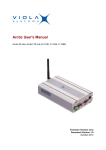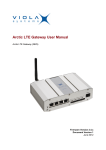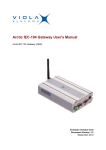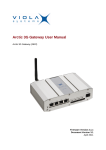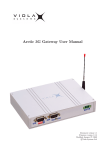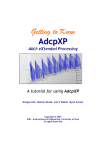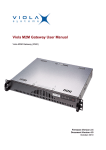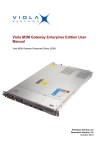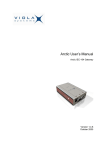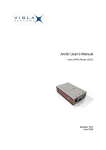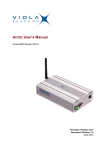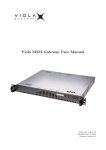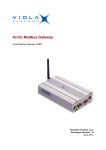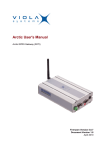Download Arctic Substation Gateway User Manual
Transcript
Arctic Substation Gateway User Manual Arctic Substation Gateway (2651) Firmware Version 2.4.x Document Version 1 March 2013 User Manual Arctic Substation Gateway Copyright and Trademark Copyright © 2008-2013, Viola Systems Ltd. All rights to this manual are owned solely by Viola Systems Ltd. (referred elsewhere in this User’s Manual as Viola Systems). All rights reserved. No part of this manual may be transmitted or reproduced in any form or by any means without a prior written permission from Viola Systems. Ethernet™ is a trademark of XEROX Corporation. Windows™ and Internet Explorer™ are trademarks of Microsoft Corporation. Netscape™ is a trademark of Netscape Communications Corporation. All other product names mentioned in this manual are the property of their respective owners, whose rights regarding the trademarks are acknowledged. Viola Systems Ltd. Lemminkäisenkatu 14-18 A FI-20520 Turku Finland E-mail: [email protected] Technical Support Phone: +358 20 1226 226 Fax: +358 20 1226 220 E-mail: [email protected] Internet: http://www.violasystems.com Firmware Version 2.4.x 2 Document Version 1 User Manual Arctic Substation Gateway Disclaimer Viola Systems reserves the right to change the technical specifications or functions of its products or to discontinue the manufacture of any of its products or to discontinue the support of any of its products without any written announcement and urges its customers to ensure that the information at their disposal is valid. Viola software and programs are delivered “as is”. The manufacturer does not grant any kind of warranty including guarantees on suitability and applicability to a certain application. Under no circumstance is the manufacturer or the developer of a program responsible for any damage possibly caused by the use of a program. The names of the programs as well as all copyrights relating to the programs are the sole property of Viola Systems. Any transfer, licensing to a third party, leasing, renting, transportation, copying, editing, translating, modifying into another programming language or reverse engineering for any intent is forbidden without the written consent of Viola Systems. Viola Systems has attempted to verify that the information in this manual is correct with regard to the state of products and software on the publication date of the manual. We assume no responsibility for possible errors which may appear in this manual. Information in this manual may change without prior notice from Viola Systems. Firmware Version 2.4.x 3 Document Version 1 User Manual Arctic Substation Gateway Declaration of Conformity (according to ISO/IEC Guide 22 and EN 45014) Manufacturer’s Name: Viola Systems Ltd. Manufacturer’s Address: Lemminkäisenkatu 14-18 A FI-20520 Turku Finland declares that this product: Product Name: Arctic Substation Gateway conforms to the following standards: EMC: EN 55022 Emission Test (Class A) 1. Radiated Emissions (30-1000MHz) 2. Conducted Emissions (0.15-30MHz) EN 50082-1 Immunity Test 1. IEC 801-3: Radio Frequency Electromagnetic Field 2. IEC 801-2: Electrostatic Discharge 3. IEC 801-4: Fast Transients, AC Power Ports and Signal cables Supplementary Information: “The product complies with the requirements of the Low Voltage Directive 73/23/EEC and EMC directive 89/336/EEC.” Note! This is a Class A product. In a domestic environment this product may cause radio Interference which may make it necessary for the user to take adequate measures. Manufacturer’s Contact Information: Viola Systems Ltd. Lemminkäisenkatu 14-18 A FI-20520 Turku Finland Phone: +358 20 1226 226 Fax: +358 20 1226 220 Firmware Version 2.4.x 4 Document Version 1 User Manual Arctic Substation Gateway Warranty and Safety Instructions Read these safety instructions carefully before using the products mentioned in this manual: Warranty will be void if the product is used in any way in contradiction with the instructions given in this manual or if the product has been tampered with. The devices mentioned in this manual are to be used only according to the instructions described in this manual. Faultless and safe operation of the devices can be guaranteed only if the transport, storage, operation and handling of the devices is appropriate. This also applies to the maintenance of the products. To prevent damage both the product and any terminal devices must always be switched OFF before connecting or disconnecting any cables. It should be ascertained that different devices used have the same ground potential. Before connecting any power cables the output voltage of the power supply should be checked. This product is not fault-tolerant and is not designed, manufactured or intended for use or resale as on-line control equipment or as part of such equipment in any hazardous environment requiring fail- safe performance, such as in the operation of nuclear facilities, aircraft navigation or communication systems, air traffic control, direct life support machines, or weapons systems, in which the failure of Viola Systems manufactured hardware or software could lead directly to death, personal injury, or severe physical or environmental damage. Firmware Version 2.4.x 5 Document Version 1 User Manual Arctic Substation Gateway Revisions Date Document Version Firmware Version Description of Changes 05/2013 1.0 - First version Firmware Version 2.4.x 6 Document Version 1 User Manual Arctic Substation Gateway Contents COPYRIGHT AND TRADEMARK ........................................................................................ 2 DISCLAIMER..........................................................................................................................3 DECLARATION OF CONFORMITY...................................................................................... 4 WARRANTY AND SAFETY INSTRUCTIONS.......................................................................5 REVISIONS............................................................................................................................ 6 1. INTRODUCTION............................................................................................................... 9 1.1 1.2 1.3 About the Arctic Substation Gateway................................................................................... 9 Arctic Substation Gateway features......................................................................................9 Packaging information........................................................................................................... 9 2. HARDWARE DESCRIPTION.......................................................................................... 10 2.1 2.2 2.3 Front panel.......................................................................................................................... 10 Back Panel.......................................................................................................................... 10 LEDs.................................................................................................................................... 11 2.3.1 Status LEDs............................................................................................................ 11 2.3.2 Ethernet LEDs.........................................................................................................12 2.4 Networking........................................................................................................................... 12 2.4.1 Mobile WAN ...........................................................................................................12 2.4.2 Ethernet WAN......................................................................................................... 12 2.4.3 Ethernet LAN...........................................................................................................13 2.5 Serial ports.......................................................................................................................... 13 2.5.1 Serial console port.................................................................................................. 13 2.5.2 Serial port 1............................................................................................................ 14 2.5.3 Serial port 2............................................................................................................ 15 2.6 Power switch and reset button........................................................................................... 16 2.7 Power connector..................................................................................................................16 2.8 Antenna connector.............................................................................................................. 16 2.9 SIM card slots..................................................................................................................... 16 2.10 DIN rail mounting................................................................................................................ 17 2.11 Product label....................................................................................................................... 17 2.12 Accessories..........................................................................................................................18 3. QUICK INSTALLATION...................................................................................................19 3.1 3.2 3.3 3.4 3.5 3.6 Connection Principle............................................................................................................19 Connecting cables............................................................................................................... 19 Logging in to Arctic Substation Gateway............................................................................19 Configuring Ethernet LAN................................................................................................... 21 Configuring Mobile WAN.....................................................................................................21 Configuring default gateway................................................................................................22 4. NETWORK CONFIGURATION....................................................................................... 23 4.1 Configuration screens..........................................................................................................23 4.1.1 Host and domain names.........................................................................................23 4.1.2 Ethernet WAN......................................................................................................... 23 4.1.3 Mobile WAN............................................................................................................ 24 4.1.4 WAN Failover.......................................................................................................... 25 4.1.5 Ethernet LAN...........................................................................................................26 Firmware Version 2.4.x 7 Document Version 1 User Manual Arctic Substation Gateway 4.2 4.3 4.4 4.1.6 Network monitor...................................................................................................... 26 Routing.................................................................................................................................27 4.2.1 Routing parameters.................................................................................................27 4.2.2 Default route............................................................................................................28 4.2.3 WAN redundancy/failover........................................................................................28 4.2.4 Routing serial <-> Ethernet.....................................................................................28 Network services................................................................................................................. 28 4.3.1 DNS proxy...............................................................................................................28 Network status information..................................................................................................28 4.4.1 System status screen..............................................................................................28 4.4.2 Mobile WAN status LEDs....................................................................................... 29 4.4.3 Modem info screen................................................................................................. 29 5. SERIAL PORT CONFIGURATION................................................................................. 31 5.1 Configuring serial gateway..................................................................................................31 6. ADDITIONAL SYSTEM CONFIGURATION.................................................................... 32 6.1 6.2 6.3 6.4 6.5 6.6 Changing system password................................................................................................ 32 Date and time......................................................................................................................32 System log...........................................................................................................................32 Factory default settings....................................................................................................... 32 Firmware update..................................................................................................................32 Configuration profiles...........................................................................................................33 7. IEC-104 APPLICATION SETTINGS............................................................................... 34 7.1 7.2 7.3 7.4 7.5 7.6 7.7 7.8 General settings.................................................................................................................. 34 Serial settings...................................................................................................................... 35 Network settings.................................................................................................................. 36 IEC-104 Settings................................................................................................................. 38 IEC-101 settings.................................................................................................................. 41 ASDU Converter..................................................................................................................44 Packet collector................................................................................................................... 45 Other settings...................................................................................................................... 47 8. TROUBLESHOOTING.....................................................................................................48 SPECIFICATIONS .............................................................................................................. 49 LIMITED WARRANTY......................................................................................................... 50 TECHNICAL SUPPORT ..................................................................................................... 51 Firmware Version 2.4.x 8 Document Version 1 User Manual Arctic Substation Gateway 1 Introduction 1.1 About the Arctic Substation Gateway The Arctic Substation Gateway product is an industrial grade wireless router for demanding IP connectivity applications. 1.2 Arctic Substation Gateway features Arctic Substation Gateway offers different advanced features. Flexible design allows the system to gain extra features if required. High speed wireless connectivity Arctic Substation Gateway has support for the latest mobile technologies, such as HSPA+ in 3G network. This allows the remote control of wide bandwidth services such as video surveillance or high amount of measurement and control channels. Flexible routing Arctic Substation Gateway can be configured to fit in all kinds of networks. It also has full support for Serial - Ethernet routing of industrial network protocols. High security Arctic Substation Gateway has highly configurable firewall and secure VPN support for secured connectivity. Redundancy and reliability Arctic Substation Gateway offers redundancy against network breakdowns and remote VPN endpoint breakdowns. This allows the overall system to achieve high availability numbers. These functionalities added to high reliability of both the hardware and software make very robust system suitable in harsh and demanding industrial environments. Remote management Arctic Substation Gateway can be managed remotely and it is easy to move configurations between units. 1.3 Packaging information The product package should contain the following items: ■ 3-pin power connector ■ Antenna ■ Arctic Substation Gateway Firmware Version 2.4.x 9 Document Version 1 User Manual Arctic Substation Gateway 2 Hardware description This section describes the physical interfaces on Arctic Substation Gateway. 2.1 Front panel Arctic Substation Gateway front panel is shown in the figure below. Figure 1. Front Panel LEDs and switches (from left to right) with section reference to more detailed information: 1. Reset button (Power switch and reset button on page 16) 2. Error LED (section LEDs on page 11) 3. Ethernet WAN port (section Ethernet WAN on page 12) 4. Ethernet LAN ports (section Ethernet LAN) 5. LEDs (section LEDs on page 11) 6. Serial console port (section Serial console port on page 13) 7. SIM card slots (section SIM card slots on page 16) 2.2 Back Panel Arctic Substation Gateway back panel is shown in the figure below. Figure 2. Back Panel Connectors (from left to right): Firmware Version 2.4.x 10 Document Version 1 User Manual Arctic Substation Gateway 1. Serial port 1 (section Serial port 1 on page 14) 2. Serial port 1 configuration DIP switches (section Serial port 1 on page 14) 3. Serial port 2 (section Serial port 2 on page 15) 4. Power switch 5. Power connector (section Power connector on page 16) 6. Antenna connector (section Antenna connector on page 16) 2.3 2.3.1 LEDs Status LEDs Arctic Substation Gateway has 11 status LEDs. They are located on the front panel (see section Front panel). Table 1: LED Description LED State Meaning Error On Unit is restarting. LED should turn off after restart (usually about 30 seconds). If the LED is constantly turned on for a long time, contact technical support. Blinking There is something wrong with the unit or the power supply causes the unit to restart constantly. Try with another power supply and if that does not help, contact technical support. Off RUN VPN Unit is operating normally. Blinking Unit is operating normally Off If the unit is turned on and RUN led is not blinking, the system has catched an error and is waiting for restart. The unit should restart soon. On VPN connection is up Blinking VPN connection is starting Off VPN connection is disabled FW - Reserved for future use SIM On SIM card has been found and it is ready for use. Blinking SIM card initialization is in progress. SIG Off SIM card is not in use On Signal level is normal or good (better than -95 dBm) Blinking Signal level is weak (between -110 dBm and -95 dBm) Off COM On There is no signal (below -110 dBm) Connection is up Blinking Connection is starting. If the connection is not coming up, check the SIM and SIG LEDs Off Firmware Version 2.4.x Connection is stopped 11 Document Version 1 User Manual Arctic Substation Gateway 2.3.2 LED State Meaning APP - Reserved for future use USR - Reserved for future use RS1 - Reserved for future use RS2 - Reserved for future use Ethernet LEDs All Ethernet ports have two LEDs to indicate the ports link and activity status. Table 2: Ethernet LED description LED State Meaning Green On Link on Blink Data received Off Link off On Full duplex Off Half duplex Yellow 2.4 2.4.1 Networking Mobile WAN Arctic Substation Gateway has a high speed wireless functionality which allows the use of bandwidth demanding wireless applications. Arctic Substation Gateway supports wireless data speeds up to 7.2 Mbit/s, however the practical data transfer rates depend on selected wireless network and network capacity. Table 3: Mobile WAN specifications 2.4.2 Networks Frequencies Maximum data rates UMTS with HSUPA (cat 11/12) 850/900/1900/2100 MHz 7.2 Mbit/s downlink / 5.76 Mbit/s uplink EDGE / GPRS class 10 850/900/1800/1900 MHz 216 kbps downlink/ 108 kbps uplink Ethernet WAN Arctic Substation Gateway has one physical port for Ethernet WAN. Specifications are shown in the table below. Firmware Version 2.4.x 12 Document Version 1 User Manual Arctic Substation Gateway Table 4: Ethernet WAN specifications Figure 3. Connector Number of ports 1 Speed 10Base-T, 100Base-TX Duplex Half and Full Autonegotiation Yes Recommended Cat5 or better cabling If Ethernet WAN interface is directly connected to computer, crossover cable must be used. Ethernet WAN interface does not support automatic MDI/MDIX detection. 2.4.3 Ethernet LAN Arctic Substation Gateway has three physical ports for Ethernet LAN. These ports are connected to a common switch. Specifications are shown in the table below. Table 5: Ethernet LAN Specifications Speed 10Base-T, 100Base-TX Duplex Half and Full Auto-negotiation Yes Recommended cabling Cat5 or better If Ethernet LAN interface is directly connected to computer, both crossover and straight cables can be used. Ethernet LAN interface supports automatic MDI/MDIX detection. 2.5 Serial ports Arctic Substation Gateway has two application serial ports and one serial console port. The application serial ports have the following differences: ■ Serial port 1 is configurable to multiple serial formats (RS-232/422/485). ■ Serial port 2 supports only RS-232 data mode. The serial port connectors are 9-pin D-sub (male) connectors. Serial ports enact as DTE devices. 2.5.1 Serial console port Serial console connector is located in Arctic Substation Gateway front panel. The connector type is RJ45. The connector is described in the table below. Firmware Version 2.4.x 13 Document Version 1 User Manual Arctic Substation Gateway Table 6: Serial console Figure 4. Connector diagram Table 7: Connector pinout Table 8: Serial port configuration Pin Function Baud rate 115200 1 CTS Data bits 8 2 DSR Parity No parity 3 RXD Stop bits 1 4 GND Flow control 5 GND No flow control 6 TXD 7 DTR 8 RTS Console port can be connected from a PC by using a Cisco compatible serial console cable. Ethernet serial console adapters are available from Viola Systems. They allow serial console access with the adapter and straight Ethernet cable. Viola Systems order code is 3170. Contact the local sales office for more details. To open serial console access a terminal program is needed. Recommended terminal programs are Tera Term and Putty. Open the connection using Ethernet LAN settings. 2.5.2 Serial port 1 Serial port 1 is configurable to multiple serial formats (RS-232/422/485). Table 9: Serial port 1 Figure 5. Connector diagram Firmware Version 2.4.x Table 10: Connector pinout (RS-232 mode) Pin Function 1 DCD 2 RXD 3 TXD 4 DTR 5 GND 6 DSR 7 RTS 14 Table 11: Serial port configuration Baud rate 115 230400 Data bits 8 Parity No parity Stop bits 1 Flow control CTS/RTS Document Version 1 User Manual Arctic Substation Gateway Pin Function 8 CTS 9 RI DIP switch configuration for serial port 1 is described in table 12. By default all are set to "0" position (RS-232 mode). DIP switches 2-4 apply only when port is set in RS-485 mode (DIP switch 1 on "1" position). Table 12: Serial port 1 DIP switches Number Function State Explanation 1 RS-232 / RS-485 0 = RS-232, 1 = RS-485 Selects serial port operation mode 2 FULL / HALF 0 = FULL, 1 = HALF Selects between half ( 2wire) and full duplex (4-wire) 3 BIAS 0 = OFF, 1 = ON RS-485 biasing 4 TERMINATION 0 = OFF, 1 = ON RS-485 termination Serial port pinouts in RS-422 and RS-485 modes are described in the table below. 2.5.3 Serial port 2 Table 13: Serial port 2 Figure 6. Connector diagram Table 14: Table 15: Serial port Connector pinout configuration Pin Function 1 DCD 2 RXD 3 TXD 4 DTR 5 GND 6 DSR 7 RTS 8 CTS 9 RI Baud rate 115 230400 Data bits 8 Parity No parity Stop bits 1 Flow control No flow control Serial port 2 supports only RS-232 data mode. Firmware Version 2.4.x 15 Document Version 1 User Manual Arctic Substation Gateway 2.6 Power switch and reset button Power switch is located on the back panel. It turns the unit on and off. Reset button is located on the front panel. Press shortly to reset the unit. Reset button can be used to restore factory default settings. To restore factory default settings, reset the unit by keeping the reset button pressed down until all the status LEDs blink. This indicates the factory presets have been applied. 2.7 Power connector Arctic Substation Gateway has a 3-pin power connector. Pinout and voltage limits are described in the table below. Supplied plug type is Phoenix Contact MC 1,5 / 3-STF-3,5 with screw fastening. Table 16: Power supply connector Figure 7. Connector Pin Symbol Function 1 + Voltage in, positive / 11 ... 18 VDC, 400 mA 2 - Voltage in, negative 3 GND Extra ground connection Arctic Substation Gateway can be also used with 2-pin power connector, pin 3 left unconnected. The unit is protected against reversed polarity within the limits of the specified voltages. Viola Systems default power supply for Arctic Substation Gateway can be ordered with order code 3020. Note that the power supply is not included in standard Arctic Substation Gateway package. 2.8 Antenna connector The Arctic Substation Gateway has a FME antenna connector (male type) for an external antenna. It is possible to use any kind of external 50 Ω quad-band antenna. 2.9 SIM card slots Note! Do not insert or remove the SIM card while the Arctic Substation Gateway is in operation. The SIM card contents may become corrupted if the card is removed while data is being written to it. Firmware Version 2.4.x 16 Document Version 1 User Manual Arctic Substation Gateway Note! If the SIM card requires a PIN code, do not install the SIM card before you set up the Arctic Substation Gateway device PIN code settings. The SIM card may become locked if the settings are not made first. Arctic Substation Gateway wireless connection requires SIM card with data transfer service enabled. The device can use two SIM cards, which can be used to make connection to two different operators. Arctic Substation Gateway can be operated using only one SIM card. To operate with SIM card follow the procedure below: 1. Power off the Arctic Substation Gateway. 2. The SIM card holder contains a tray with a yellow eject button. Push this button to eject the tray from the holder. 3. Put the SIM card onto the tray. 4. Insert the tray carefully back to the holder and press the tray until it is locked. If two SIM cards are used, repeat the procedure for SIM slot 2. 2.10 DIN rail mounting Arctic Substation Gateway has mounting holes for optional DIN rail mounting brackets. Viola Systems order code for DIN rail mounting kit is 3003. Contact the local Viola Systems distributor for more details. Mounting instructions: 1. Required tools and accessories are: DIN rail mounting kit (2 mounting brackets and 4 screws), screw driver. 2. Use the screw driver to attach the screws to bthe ottom panel of the Arctic LTE. DIN rail brackets are installed to either diagonally or horisontally depending on the wanted DIN rail installation angle. 2.11 Product label Product label is found on the bottom of the device and it contains the basic information about the unit such as product name, serial number and Ethernet MAC address. Figure 8. Product label Firmware Version 2.4.x 17 Document Version 1 User Manual Arctic Substation Gateway 2.12 Accessories Viola Systems supplies certain accessories for Arctic Substation Gateway. Possible accessories are listed in the table below. Table 17: Arctic Substation Gateway accessories Accessory Order code Serial console adapter: RS232 to RJ45 3170 DIN rail monting kit: 2 DIN rail clips with screws 3003 Optional power supply: 12V/1.5A with universal 100-240VAC IEC input 3020 Accessory kit: Serial console adapter, Ethernet cables, power supply 3221 Firmware Version 2.4.x 18 Document Version 1 User Manual Arctic Substation Gateway 3 Quick Installation This chapter describes how to configure the WAN network interfaces on Arctic Substation Gateway. 3.1 Connection Principle Arctic Substation Gateway has three network interfaces, Ethernet WAN, Mobile WAN and Ethernet LAN. The WAN interfaces are used for connecting Arctic Substation Gateway to public Internet or private APN. Ethernet LAN is used for connecting other Ethernet devices to Arctic Substation Gateway's local network. The WAN interfaces can be configured to get redundant system where one WAN automatically gets traffic if the other one goes down. For example, if the Ethernet LAN goes down, the traffic is automatically switched to mobile WAN and back when the Ethernet interface comes up again. This way the availability of the remote system is better than with just one interface. 3.2 Connecting cables 1. Verify that the power switch is in the OFF position. 2. Connect the Ethernet cable between Arctic Substation Gateway (Ethernet LAN connector) and the computer used for the configuration. 3. Connect power supply to Arctic Substation Gateway and toggle the power switch to ON position. 4. The error LED should turn on immediately after the power switch is turned on. 5. After the system has initialized, the Error LED turns off and the RUN LED starts to blink. 3.3 Logging in to Arctic Substation Gateway This section describes how to log in to Arctic Substation Gateway using web configuration menu. Firmware Version 2.4.x 19 Document Version 1 User Manual Arctic Substation Gateway 1. Configure the computer to use the same IP address space than Arctic Substation Gateway (laptop IP for example 10.10.10.11 with netmask 255.0.0.0). Check with ping command. 2. Connect to the Arctic Substation Gateway using the web browser. The default IP address of Arctic Substation Gateway is 10.10.10.10 (netmask 255.0.0.0). Please make sure to connect to a HTTPS port (see the figure below). Figure 9. Browser https example Note! The browser request for the certificates and can be ignored at this point. Firmware Version 2.4.x 20 Document Version 1 User Manual Arctic Substation Gateway 3. Enter the username and password and press Login button in the log-in screen. The actual screen depends on the used web browser. Note! Default username is viola-adm and default password is violam2m. It is recommended that the default password is changed before the product is connected to a public network. 4. White texts on the blue background on the left are the primary navigation texts and they are always visible on the screen. Individual screens may have their own tabs which split the configuration fields on larger screens. See the figure below. Figure 10. Configuration menu 3.4 Configuring Ethernet LAN 1. Select Network->Ethernet LAN from the left menu. 2. Enter the preferred configuration to the configuration fields. 3. Press Submit button on the bottom to save the settings. 4. Select Tools->Reboot from the left menu and press Reboot button to restart the unit If the IP addresses are changed, the existing web browser connection hangs up once the settings are applied, so open a new connection to the new IP address (check the Ethernet cabling) 5. Connect to the Arctic Substation Gateway with a new IP address. 3.5 Configuring Mobile WAN 1. Select Network->Mobile WAN from the left menu. 2. Enter the preferred configuration to the configuration fields. 3. Press Submit button on the bottom to save the settings. Firmware Version 2.4.x 21 Document Version 1 User Manual Arctic Substation Gateway 3.6 Configuring default gateway 1. Select Network->WAN Failover from the left menu. 2. Set "WAN Default Route"="Yes". This has to be enabled to use either WAN as default route interface. 3. If the mobile WAN has to be set as a default gateway, set "Primary WAN Interface"="Mobile WAN". 4. If Ethernet WAN has to be set as a default gateway, set "PrimaryWAN Interface"="EthernetWAN". 5. If both Ethernet WAN and Mobile WAN configured, define the Backup WAN Interface. If the primary WAN interface comes down, Arctic Substation Gateway automatically switches default route to backup WAN interface. The figure below shows example configuration where Ethernet WAN is configured as default route. Figure 11. Ethernet WAN default route example 6. Press Submit on the bottom to save the settings. 7. Select Tools->Reboot from the left menu and press Reboot button to restart the unit. Firmware Version 2.4.x 22 Document Version 1 User Manual Arctic Substation Gateway 4 Network Configuration 4.1 Configuration screens The web user interface has a navigation menu that is always visible on the left pane. In the menu, the items are grouped together in sections such as System, Network, VPN and Firewall. Figure 12. Web user interface 4.1.1 Host and domain names Host and domain names can be set from the System General Settings screen. Figure 13. General Settings 4.1.2 Ethernet WAN This screen configures the Ethernet WAN interface on Arctic Substation Gateway. Firmware Version 2.4.x 23 Document Version 1 User Manual Arctic Substation Gateway Figure 14. Ethernet WAN configuration Connectivity Monitor settings are used when WAN redundancy functionality is required. Monitor keeps checking the connection to the given remote host to determine the network status. If the ping does not get an answer for a given time window, it informs the WAN switch logic to try the secondary interface. If the WAN redundancy is implemented by using two separated Ethernet connections with different gateways, the Backup Gateway parameter needs to be configured towards the correct backup gateway. Backup Gateway parameter is not needed if WAN redundancy is implemented with wireless connection. See section WAN Failover on page 25 for more details about WAN redundancy. 4.1.3 Mobile WAN This screen configures the Mobile WAN interface on Arctic Substation Gateway. Firmware Version 2.4.x 24 Document Version 1 User Manual Arctic Substation Gateway Figure 15. Mobile WAN configuration To configure the mobile WAN, enable the connection by selecting "Enable"="Yes" on the top of the page and enter PIN code if set, APN name and authentication details if needed. If Arctic Substation Gateway acts as a wireless router to Ethernet devices and DNS is needed, enter DNS configuration as well. When ready, press the Submit button on the bottom of the page to save settings. Arctic Substation Gateway need to be restarted before the mobile WAN configuration is active. 4.1.4 WAN Failover WAN Failover screen configures the default gateway settings on the Arctic Substation Gateway. Firmware Version 2.4.x 25 Document Version 1 User Manual Arctic Substation Gateway Figure 16. WAN Failover configuration To enable any default routes, set "WAN Default Route"="Yes". Any route settings are not effective if this parameter is not enabled. Set "On Demand"="Yes" if the backup WAN interface to come up only when primary interface goes down. Disable if both wireless and wired WAN interfaces have to be up all the time. 4.1.5 Ethernet LAN This screen configures the Ethernet LAN interface on Arctic Substation Gateway. Figure 17. Ethernet LAN Configuration Ethernet LAN configuration is very simple. It configures the IP address for the Ethernet LAN interface. 4.1.6 Network monitor This screen configures the interface connectivity monitor on Arctic Substation Gateway. Firmware Version 2.4.x 26 Document Version 1 User Manual Arctic Substation Gateway Figure 18. Network monitor configuration When using VPN, the usage of the monitor is heavily recommended to detect the connection drops. 4.2 4.2.1 Routing Routing parameters There are multiple configuration options that define the routing on Arctic Substation Gateway: ■ Ethernet WAN - Gateway (IP address) ■ IP address of router used to reach the internet. Leave empty if unused. ■ Ethernet WAN - Backup Gateway (IP address) ■ IP address of backup router used to reach the internet. Leave empty if unused. ■ WAN Failover - WAN Default Route (selection: Yes/No) ■ Usually "Yes" if default route is defined by "static routes". If the selection logic is done on VPN level select "No" ■ WAN Failover - On Demand (selection: Yes/No) ■ Select "Yes" to activate the backup interfaces only when required. Select "No" to have all the WAN interfaces to be available simultaneously for e.g. VPNs. ■ WAN Failover - Primary WAN Interface (selection: None/Mobile WAN/ Ethernet WAN/Ethernet WAN Secondary) ■ WAN Failover - Backup WAN Interface(selection: None/Mobile WAN/ Ethernet WAN/Ethernet WAN Secondary) Firmware Version 2.4.x 27 Document Version 1 User Manual Arctic Substation Gateway 4.2.2 ■ WAN Failover - Secondary Backup WAN Interface (selection: None/Mobile WAN/Ethernet WAN/Ethernet WAN Secondary) ■ These three settings configure the high level default gateways. Must be configured to enable default route. ■ OpenVPN Client Settings - Interface (selection: Any WAN/Ethernet WAN/ Wireless WAN/Ethernet LAN) ■ Which Interface to use for connection ■ OpenVPN Client Settings - Routing mode (selection: None/host/net/default route) ■ This defines how the routing is configured with OpenVPN. See OpenVPN application note. Default route Default route can be configured from WAN Failover screen. See section WAN Failover on page 25. 4.2.3 WAN redundancy/failover To configure redundancy between WAN interfaces, configure multiple WAN interfaces to WAN Failover. See section WAN Failover on page 25. 4.2.4 Routing serial <-> Ethernet See section Configuring serial gateway on page 31 for configuring serial gateway. 4.3 4.3.1 Network services DNS proxy To use this feature, configure the device to use Arctic Substation Gateway Ethernet LAN IP address as its DNS server. This way, the DNS queries from the device get routed through the Arctic Substation Gateway. 4.4 4.4.1 Network status information System status screen Network status information can be seen from System > Status screen . Firmware Version 2.4.x 28 Document Version 1 User Manual Arctic Substation Gateway Figure 19. Network status screen 4.4.2 Mobile WAN status LEDs Status of mobile WAN interface can be viewed from the front panel LEDs. The initialization sequence is: 1. COM LED starts to blink when the connection is started. 2. SIM LED starts to blink when SIM card is searched and turns on when the card is found and PIN code accepted. 3. SIM LED starts to blink when the operator network is searched and gets lit when the network is found. 4. COM LED gets lit when the connection is up. 4.4.3 Modem info screen In troubleshooting situations, checking the system logs helps to identify the problem. Also modem info page can be used to check the status of the wireless modem. Firmware Version 2.4.x 29 Document Version 1 User Manual Arctic Substation Gateway Figure 20. Modem info screen Firmware Version 2.4.x 30 Document Version 1 User Manual Arctic Substation Gateway 5 Serial Port Configuration 5.1 Configuring serial gateway This section describes how to configure serial <-> Ethernet functionality. Serial gateway feature enables data from the serial port attached device to be routed to Ethernet and vice versa. Serial gateway processes the transmitted data transparently and does not alter it any way except for buffering it for transmission. Because of the transparent communication, any protocols can be used in actual communication between nodes. Figure 21. Serial gateway configuration screen Serial gateway configuration depends on used protocols. Both serial ports have their own configuration screens, located in Applications->Serial Gateway (RS1) and Applications->Serial Gateway (RS2). Firmware Version 2.4.x 31 Document Version 1 User Manual Arctic Substation Gateway 6 Additional System Configuration 6.1 Changing system password Username and password can be changed from Tools->User Config screen. It is always recommended to change the password from the factory default when the Arctic Substation Gateway is connected to a public network. Also console access password can be changed. Figure 22. User Config screen 6.2 Date and time Date and time can be changed from System->Time screen. Date and time can be configured either manually entering the time or automatically from connected PC. Figure 23. System time configuration screen To set time manually, enter the time and then press Submit button. To copy time from PC, press Copy PC button and answer "Yes" to question about changing time. Note that the PC may not necessarily have correct time set and that needs validation. Also note that the copy functionality requires JavaScript support from the browser. 6.3 System log System log is visible on the Tools->System Log screen. To refresh the system log, use web browser reload button. 6.4 Factory default settings Factory default settings can be applied by restarting the unit pressing down reset button until the LEDs blink. 6.5 Firmware update Current running firmware version can be viewed from the System->Status screen. Arctic Substation Gateway firmware can be updated from the Tools>Firmware Update screen. Firmware Version 2.4.x 32 Document Version 1 User Manual Arctic Substation Gateway Figure 24. Firmware update screen Firmware update erases all the settings on the unit to the factory defaults. It is recommended to create backup from the old configuration before attempting to update the firmware. To update firmware: 1. Verify for a valid firmware on the PC before attempting to update the firmware. 2. Select Select file button to open file browsing dialog. The actual dialog depends on the used browser. 3. Select the updated firmware from the file dialog and return to the firmware update screen. 4. Press Update button to start the firmware update. 5. Confirm the update. 6. The update takes a few minutes and the unit restarts with factory default settings when the update is completed. 6.6 Configuration profiles Profiles can be configured and saved for future use. Several profiles are created and selected for the activation. It is possible to import, export and clone profiles, and also reset them to factory default settings. Figure 25. Configuration profiles Firmware Version 2.4.x 33 Document Version 1 User Manual Arctic Substation Gateway 7 IEC-104 application settings The IEC-104 and IEC-101 protocols share the same ASDU level messaging but differ on the link level. The IEC-104 is intended for packet-switched TCP/ IP communication whereas the IEC-101 is intended for serial communication. By using the Arctic Substation Gateway, the IEC-101 slaves (e.g. RTUs) can be connected to a IEC-104 master (e.g. SCADA). The Arctic requests event from the IEC-101 slave locally and sends them to the IEC-104 master. This eliminates the need to continuously poll the data remotely and therefore reduces the communication costs on pay-per-use wireless network. This approach also eliminates the IEC-101 parameter adjutancy problems caused by variable round-trip delays on wireless networks and makes the information exchange faster and more reliable. You can view and change the application settings in Applications > IEC-104 (RSx). Figure 26. IEC-104 Application Settings 7.1 General settings IEC-104 gateway enabled Enables or disables IEC-104 to IEC-101 gateway functionality. Table 18: IEC-104 gateway enabled IEC-104 gateway enabled Type Boolean Units N/A Firmware Version 2.4.x 34 Document Version 1 User Manual Arctic Substation Gateway IEC-104 gateway enabled Value range No, Yes Note 7.2 Serial settings The serial settings define the properties of physical serial communication between the Arctic and an IEC-101 slave. The selection between RS-232/422/485 is done with physical DIP switches located below the RS2 serial port. Figure 27. Serial Settings Speed (bps) Table 19: IEC-101 serial communication speed (bps) IEC-101 serial communication speed (bps) Type Serial speed Units Bits per second Value range 1200, 2400, 4800, 9600, 19200, 38400, 57600 Note Data bits Table 20: Number of data bits used on IEC-101 serial communication Number of data bits used on IEC-101 serial communication Type Serial data bits Units Bits Value range 5, 6, 7, 8 Note Parity Table 21: Parity method used on IEC-101 serial communication Parity method used on IEC-101 serial communication Type Serial data parity Units Bits Firmware Version 2.4.x 35 Document Version 1 User Manual Arctic Substation Gateway Parity method used on IEC-101 serial communication Value range None, Even, Odd Note Stop bits Table 22: Number of stop bits used on IEC-101 serial communication Parity method used on IEC-101 serial communication Type Serial data stop bits Units Bits Value range 1, 2 Use HW flow control Table 23: Number of stop bits used on IEC-101 serial communication HW flow control mechanism (RTS/CTS) on IEC-101 serial communication 7.3 Type Boolean Units N/A Value range Yes, No Note The HW handshaking is available only on RS-232 mode. Network settings The Network settings define the general TCP/IP networking properties between the Arctic and the IEC-104 master. Figure 28. Network Settings Network protocol Network protocol defines the network transmission layer protocol (either TCP or UDP) used on IEC-104 network communication. The IEC-104 standard protocol uses TCP but for reliable slow speed packet switched networks (e.g. Mobitex), the UDP protocol can be used to minimize the packets transmitted over network. Table 24: Network protocol on IEC-104 communication Network protocol on IEC-104 communication Type Firmware Version 2.4.x Network transmission layer protocol 36 Document Version 1 User Manual Arctic Substation Gateway Network protocol on IEC-104 communication Units N/A Value range UDP, TCP Note The IEC-104 standard specifies only TCP protocol. Network port to listen Table 25: TCP or UDP port to listen for incoming IEC-104 connections TCP or UDP port to listen for incoming IEC-104 connections Type Network port Units Port number Value range 0 - 65000 Note The IEC-104 standard specifies TCP port 2404. Network idle timeout It defines the idle timeout of the network connection in seconds. If there is no network data received during the specified interval, the connection is closed by Arctic. This parameter is required in order to detect partially closed connections and release the resources for new connections especially if the”New connection priority” parameter is disabled. Value 0 disables the network idle timeout detection. Table 26: Network idle timeout for IEC-104 connections Network idle timeout for IEC-104 connections Type Timeout Units Seconds Value range 0 – 65000 Note The network idle timeout must be longer than IEC-104 link test interval (t3). New connection priority It defines the action when a new connection request arrives while a connection is already active. If the set value is”No”, the new connection is rejected. If the set value is”Yes”, the present connection is terminated and the new connection is accepted. Table 27: New connection priority for IEC-104 connections New connection priority for IEC-104 connections Type Boolean Units N/A Value range No, Yes Note It is recommendable to set this value to “Yes” in normal configurations having only one IEC-104 master. Firmware Version 2.4.x 37 Document Version 1 User Manual Arctic Substation Gateway 7.4 IEC-104 Settings The IEC-104 settings define the properties of IEC-104 link layer and application layer parameters as described in the IEC 60870-5-104 standard. The IEC-104 communication is carried out between the Arctic and the IEC-104 master over the TCP/IP network. Figure 29. IEC-104 Settings TX window size (k) TX window size defines the maximum number of I format APDUs the Arctic may send before requiring the IEC-104 master to acknowledge them. If there are k unacknowledged frames sent the Arctic will stop polling IEC-101 slave for events until acknowledgement is received. Table 28: IEC-104 TX windows size (k) IEC-104 TX windows size (k) Type Window size Units Packets Value range 1-20 Note The k must be always less than the maximum sequence number defined below. The IEC-104 standard suggests k to be 12. RX window size (w) It defines the maximum number of I format APDUs the Arctic may receive before sending acknowledgement to the IEC-104 master. Table 29: IEC-104 RX windows size (w) IEC-104 RX windows size (w) Type Firmware Version 2.4.x Window size 38 Document Version 1 User Manual Arctic Substation Gateway IEC-104 RX windows size (w) Units Packets Value range 1-20 Note The w should not exceed two-thirds of TX window size k. The IEC-104 standard suggests w to be 8. I frames TX timeout (t1) It defines the timeout in seconds the Arctic waits for acknowledgement from IEC-104 master after sending last I format APDU or control frame (e.g. link test). If no acknowledgement is received during the defined time the Arctic will close the network connection and the IEC-101 link. Table 30: IEC-104 I frames TX timeout (t1) IEC-104 I frames TX timeout (t1) Type Timeout Units Seconds Value range 1-255 Note The t1 must be longer than the network round-trip-time. The IEC-104 standard suggests 15 seconds. I frames RX timeout (t2) This defines the timeout in seconds from the last received I format APDU before sending acknowledgement. Table 31: IEC-104 I frames RX timeout (t2) IEC-104 I frames RX timeout (t2) Type Timeout Units Seconds Value range 1-255 Note The t2 must be smaller than t1. The IEC-104 standard suggests 10 seconds. Link test interval (t3) This defines the interval in seconds how often the IEC-104 link is tested if there is no other activity. Table 32: IEC-104 link test interval (t3) IEC-104 link test interval (t3) Type Timeout Units Seconds Value range 1-65000 Firmware Version 2.4.x 39 Document Version 1 User Manual Arctic Substation Gateway IEC-104 link test interval (t3) Note Adjust this parameter according to the criticality of the link. The IEC-104 standard suggests 20 seconds but for pay-per-use GPRS connections the practical value may be substantially longer. Suspended timeout This defines the time in seconds how long a connected IEC-104 link can be in suspended state (STOPD) before the Arctic closes the connection. Table 33: IEC-104 suspended timeout IEC-104 suspended timeout Type Timeout Units Seconds Value range 1-65000 Note Using this parameter increases the probability of detecting partially closed network connections especially in UDP mode. Max sequence number These are the maximum sequence number used in IEC-104 communication. The value zero selects the standard value 32767. Table 34: IEC-104 suspended timeout IEC-104 suspended timeout Type Sequence number Units Packets Value range 1-32767 Note 0 = 32767 as suggested by the IEC-104 standard. Cause of transmission length (IEC-104) It defines the length of IEC-104 Cause of transmission ASDU header field in bytes. Table 35: IEC-104 ASDU cause of transmission length IEC-104 ASDU cause of transmission length Type Field length Units Bytes Value range 1-3 Note The IEC-104 standard defines value 2. Common address length (IEC-104) This defines the length of IEC-104 Common address ASDU header field in bytes. Firmware Version 2.4.x 40 Document Version 1 User Manual Arctic Substation Gateway Table 36: IEC-104 ASDU common address length IEC-104 ASDU common address length Type Field length Units Bytes Value range 1-3 Note The IEC-104 standard defines value 2. Info object address length (IEC-104) This defines the length of IEC-104 Information object address ASDU header field in bytes. Table 37: IEC-104 ASDU information object address length IEC-104 ASDU information object address length 7.5 Type Field length Units Bytes Value range 1-3 Note The IEC-104 standard defines value 3. IEC-101 settings The IEC-101 settings define the properties of IEC-101 link layer and application layer parameters as described in the IEC 60870-5-101 standard. The IEC-101 communication is carried out between the Arctic and a IEC-101 slave. Figure 30. IEC-101 Settings Slave link address (IEC-101) Table 38: IEC-101 slave link address IEC-101 slave link address Type Firmware Version 2.4.x Link address 41 Document Version 1 User Manual Arctic Substation Gateway IEC-101 slave link address Units N/A Value range 1-65000 Note The link-level address of IEC-101 slave. Link address field length Defines the length of the IEC-101 link-level address field in bytes. Table 39: IEC-101 slave link address field length IEC-101 slave link address field length Type Field length Units Bytes Value range 1, 2 Note The link-level address of IEC-101 slave. Event poll interval It defines the IEC-101 event polling interval in 0.1 second increments (class 1 or 2 poll). Table 40: IEC-101 event poll interval IEC-101 event poll interval Type Interval Units 0.1 seconds Value range 1-65000 Note The events are polled only when the IEC-104 connection is active. Link test interval It defines the IEC-101 link test interval in 0.1 second increments. Link test is performed if there is no other activity. Table 41: IEC-101 link test interval IEC-101 link test interval Type Interval Units 0.1 seconds Value range 1-65000 Note The link test is performed if there is no other activity during defined interval. Keep link open Defines that the IEC-101 link is kept always open even when there is no active IEC-104 connection. If the functionality is enabled the Arctic sends link test Firmware Version 2.4.x 42 Document Version 1 User Manual Arctic Substation Gateway frames and restarts the IEC-101 link if the test fails. The events are still not polled before the IEC-104 connection is active. Table 42: IEC-101 keep link open IEC-101 keep link open Type Boolean Units N/A Value range No, Yes Note Some IEC-101 slaves require the link to be continuously open in order to operate. Reply header timeout Defines the timeout Arctic waits the reply to start from IEC-101 slave after command or request. Table 43: IEC-101 reply start timeout IEC-101 reply start timeout Type Timeout Units Milliseconds Value range 1-65000 Note Reply end timeout Defines the maximum duration of IEC-101 slave response. Table 44: IEC-101 reply end timeout IEC-101 reply end timeout Type Timeout Units Seconds Value range 1-65000 Note Retry limit Defines the number of retries sent to a IEC-101 slave in case of no reply. If no reply is still received the Arctic closes the IEC-101 and IEC-104 connections. Table 45: IEC-101 retry limit IEC-101 retry limit Type Retry limit Units Retries Firmware Version 2.4.x 43 Document Version 1 User Manual Arctic Substation Gateway IEC-101 retry limit Value range 0-65000 Note Cause of transmission length (IEC-101) Defines the length of IEC-101 Cause of transmission ASDU header field in bytes. Table 46: IEC-101 ASDU cause of transmission length IEC-101 ASDU cause of transmission length Type Field length Units Bytes Value range 1-3 Note The IEC-101 standard defines value 1. Common address length (IEC-101) Defines the length of the IEC-101 Common address ASDU header field in bytes. Table 47: IEC-101 ASDU common address length IEC-101 ASDU common address length Type Field length Units Bytes Value range 1-3 Note The IEC-101 standard defines value 2. Info object address length (IEC-101) Defines the length of IEC-101 Information object address ASDU header field in bytes. Table 48: IEC-101 ASDU information object address length IEC-101 ASDU information object address length 7.6 Type Field length Units Bytes Value range 1-3 Note The IEC-101 standard defines value 2. ASDU Converter The ASDU converter can be used to convert ASDU header field lengths between IEC-101 and IEC-104 protocols. Firmware Version 2.4.x 44 Document Version 1 User Manual Arctic Substation Gateway Figure 31. ASDU Converter Use ASDU converter This defines if the ASDU header level IEC-101 <-> IEC-104 conversion performed. If enabled the ASDU header field lengths are converted between IEC-104 and IEC-101. This parameter must be enabled if the ASDU header lengths differ between the IEC-104 and the IEC-101. Table 49: Use ASDU converter Use ASDU converter Type Boolean Units N/A Value range No, Yes Note The information on the field must fit in the shorter one of the two. It’s not possible to convert e.g. value 12000 to a one byte field. Use ASDU type replacer The ASDU type replace function can be used to convert an ASDU type (Original type) to another (Applied type) type e.g. in cases when the IEC implementation differs between master and slaves. Table 50: Use ASDU type replacer Use ASDU type replacer Type Boolean Units N/A Value range No, Yes Note Original type The original ASDU type searched by ASDU type replacer. Applied type The new ASDU type is replaced by the original type. 7.7 Packet collector The packet collector can be used to collect many IEC-101 messages/events to a single network packet instead of sending every message separately. Firmware Version 2.4.x 45 Document Version 1 User Manual Arctic Substation Gateway This function is useful for slow packet switched communication network (e.g. Mobitex) for speeding up especially the general interrogation response. Figure 32. Packet Collector Use packet collector Table 51: Use packet collector Use packet collector Type Boolean Units N/A Value range No, Yes Note Max bytes Max bytes is defined as the maximum bytes trigger for packet collector. Before a new packet is inserted into the packet collector buffer the amount of bytes is checked. If the insertion of the new packet would cause the number of bytes in the packet collector to exceed MAX BYTES the old content is sent to the network before inserting the new one. Table 52: Maximum collected bytes Maximum collected bytes Type Packet size Units Bytes Value range 1-1500 Note The value should be smaller than the MTU/MRU of network used. Max time Max time is deived as the maximum collect time trigger for packet collector in 0.1 secs increments for packet collector. If there has been data on packet collector over MAX TIME the data is sent to network. Table 53: Maximum collected time Maximum collected time Type Timeout Units 0.1 seconds Firmware Version 2.4.x 46 Document Version 1 User Manual Arctic Substation Gateway Maximum collected time Value range 1-255 Note The value must be smaller than t1. Max packets Max packets are defined as the maximum amount of IEC-101 packets stored into the packet collector before sending the data to the network. Table 54: Maximum collected packets Maximum collected packets Type Packet count Units Packets Value range 1-255 Note 7.8 Other settings Write syslog It defines whether the error messages are stored to system log file or not. Table 55: Write system log Write system log Type Boolean Units N/A Value range No, Yes Note The system log is available by using WEB UI. Firmware Version 2.4.x 47 Document Version 1 User Manual Arctic Substation Gateway 8 Troubleshooting Q: Wireless WAN is not coming up A: Check settings (Mobile WAN on page 24), SIM card and signal level. An easy way to check the connection status is checking the LEDs, see section Mobile WAN status LEDs on page 29. Q: OpenVPN is not working A: For more information, see OpenVPN application note. Send a request to [email protected] for the note. Q: Serial ports are not working A: For more information, see serial port chapter notes. Verify DIP switch configuration if RS-422 or 485 modes are being used. Q: Can not access web user interface A: Web user interface uses HTTPS for secure web access and it must be specified on the web browser address field like in this example: https://10.10.10.10. Q: Cannot access the Internet with laptop connected to Arctic Substation Gateway A: Testing the mobile WAN connection: 1. Configure mobile WAN connection and verify if it connected to the network 2. Connect a laptop to Ethernet LAN 3. Check that S-NAT rule on the firewall is set as "Action"="Masquerade" and "Destination Inter- face"="Mobile WAN". 4. Check that DNS Proxy is enabled from Services->Common screen. 5. Configure network settings on laptop to use Arctic Substation Gateway Ethernet LAN address as gateway and DNS server. With these setting, the Internet should be accessible on the laptop. Firmware Version 2.4.x 48 Document Version 1 User Manual Arctic Substation Gateway Specifications Table 56: Technical specifications Processor 400MHz Memory (RAM) 64MB Hard Drive (flash) 32MB Input voltage (nominal) 12-36VDC Power consumption 7W max Power connector Phoenix Contact MC 1,5/ 3-STF-3,5 Casing Aluminium sheet Operating temperature -25 - 70 °C Storage temperature -40 ... +85 C Humidity 0 ... 99 % non-condensing Network connection 10/100M Approvals CE Size 165 x 120 x 46 mm Weight 0.6 kg Antenna connector type is FME (male). Table 57: Application serial port specifications Serial mode (RS1) RS-232 / 422 / 485 Serial mode (RS2) RS-232 Baud rate 300 - 460800 Data bit 5/6/7/8 Parity None / Even / Odd Stop bits 1/2 Flow control None / Hardware (RTS/CTS) / Software (XON/ XOFF) Techical specifications can be changed without notification. Firmware Version 2.4.x 49 Document Version 1 User Manual Arctic Substation Gateway Limited Warranty Coverage Viola Systems warrants this hardware product to be free from defects in materials and workmanship for the warranty period. This non-transferable, limited warranty is only for the first end-user purchaser. The warranty begins on the date of purchase and lasts for the period specified below: Arctic Substation Gateway: one (1) year Excluded Products and Problems This warranty does not apply to: (a) Viola Systems software products; (b) expendable components such as cables and connectors; or (c) third party products, hardware or software, supplied with the warranted product. Viola Systems makes no warranty of any kind on such products which, if included, are provided "AS IS." Excluded is damage caused by accident, misuse, abuse, unusually heavy use, or external environmental causes. Remedies The sole and exclusive remedy for a covered defect is repair or replacement of the defective product, at Viola Systems’ sole option and expense, and Viola Systems may use a new or refurbished parts or products to do so. If Viola Systems is unable to repair or replace a defective product, an alternate exclusive remedy shall be a refund of the original purchase price. The above is Viola Systems’ entire obligation to you under this warranty. IN NO EVENT SHALL VIOLA SYSTEMS BE LIABLE FOR INDIRECT, INCIDENTAL, CONSEQUENTIAL OR SPECIAL DAMAGES OR LOSSES, INCLUDING LOSS OF DATA, USE, OR PROFITS EVEN IF VIOLA SYSTEMS HAS BEEN ADVISED OF THE POSSIBILITY OF SUCH DAMAGES. In no event shall Viola Systems’ liability exceed the original purchase price of the device server. Some states or countries do not allow the exclusion or limitation of incidental or consequential damages, so the above limitation or exclusion may not apply. Obtaining Warranty Service It must be notified to Viola Systems within the warranty period to receive warranty service. During the warranty period, Viola Systems will repair or replace, at its option, any defective products or parts at no additional charge, provided that the product is returned, shipping prepaid, to Viola Systems. All replaced parts and products become the property of Viola Systems. Before returning any product for repair, customers are required to contact the Viola Systems. Firmware Version 2.4.x 50 Document Version 1 User Manual Arctic Substation Gateway Technical Support Contacting Technical Support Phone: +358 20 1226 226 Fax: +358 20 1226 220 E-mail: [email protected] Internet: http://www.violasystems.com Recording Arctic Information Before contacting our Technical Support staff, please record (if possible) the following information about the Arctic product: Product name: ___________________________________________________ Serial no: _______________________________________________________ Note the status of the Arctic in the space below before contacting technical support. Include information about error messages, diagnostic test results, and problems with specific applications. ___________________________________________________________________ ___________________________________________________________________ ___________________________________________________________________ Firmware Version 2.4.x 51 Document Version 1



















































